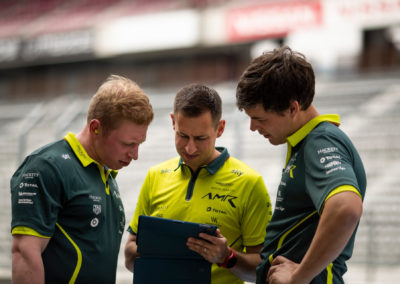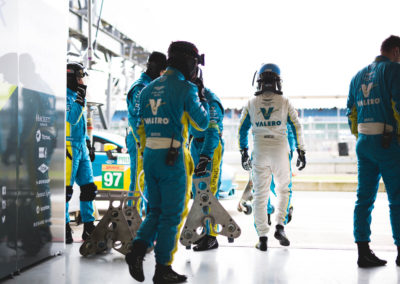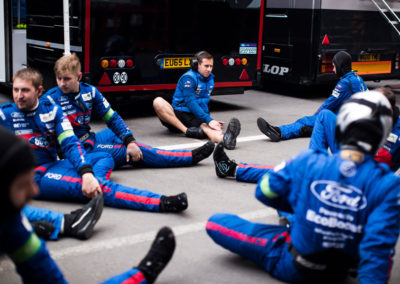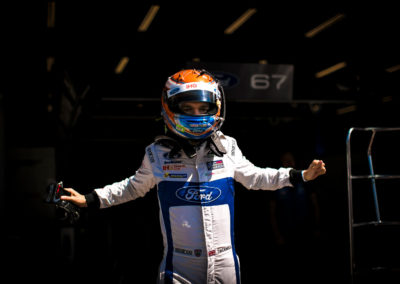MOTORSPORT
AT THE TRACK: WHAT WE DO
We help drivers and teams achieve a competitive edge by providing the following support:
■ Warm-up techniques for drivers before each stint in the car
■ Real-time performance analysis
■ Driver hydration management in and out of the car
■ Advice on appropriate race nutrition for teams and drivers in conjunction with our nutrition partner Science in Sport
■ Recovery strategies following each stint including sports massage therapy, stretching and sweat testing protocols
■ Sports massage therapy and injury prevention for technicians and engineers as required
■ Pit stop physiological analysis using Coaches Eye software to help refine strategy, prevent injuries and reduce errors
■ Assistance with driver kit management
■ Assistance with logistics related to driver PR and media obligations
WHY MONITOR PHYSIOLOGICAL PERFORMANCE?
Every aspect of a racing car is meticulously engineered and monitored for optimal efficiency, but historically the same level of attention has not been on a driver’s performance.
A race driver is the key component in the car, so having the ability to measure a driver’s physiological performance in real-time is as essential as the car itself. Monitoring variables such as heart rate, breathing rate, core body temperature, G-forces and blood glucose levels allows an engineer to make strategic decisions in a competitive environment.
For example, a sudden drop in breathing rate would suggest the driver is holding their breath at certain sections of the circuit. Throughout a stint, this would compromise the oxygen supply to their brain, reduce cognitive function resulting in a significant increase to overall energy expenditure. Also, if the driver’s core temperature were to reach 39 degrees Celsius, this would be detrimental to mental focus and reaction time.
Aside from a performance perspective, physiological monitoring is also crucial concerning driver safety. Racing drivers are subject to physical extremes; for example, in the World Endurance Championship, the regulations state that cockpit temperatures are allowed to reach 32 degrees Celsius and frequently do. This, combined with G-forces on the driver, can mean that they are physically ‘on the limit.’ At this high level of physical exertion, the potential for making an error is increased.
Real-time physiological monitoring can help pre-empt racing errors, especially if it is used in conjunction with on-board video footage.
PHYSIOLOGICAL THRESHOLDS
The physiological variables that we can measure in real-time are:
■ Heart rate
■ Breathing rate
■ Core temperature
■ G-forces on the driver
■ Blood glucose levels
TRAINING TOOL
Away from the track – individual physical output in the car can be applied in the gym environment to prepare and help tolerate this level of exertion for extended durations.
Track preparation – breath holding at certain sections of a race track needs to be followed by highlighted areas where ‘physical downtime’ is possible to manage expenditure throughout a stint. This is particularly effective when using the physiological monitoring system in conjunction with simulator work.
Refining driving technique – an overlay of physical performance such as driving posture against braking pressure can be used to evaluate braking consistency. Using the physical data in combination with on-board footage can also be used to assess shoulder tension or excessive gripping on the steering wheel.
Warm-up routine – typical average heart rates in a racing car are 150bpm +/- 15bpm, so to go from a resting level of 60-80bpm straight to this level of physical output is a significant ‘shock’ to the cardiovascular system. This can produce variability in physical consistency over the course of a stint. Ideally, a driver should warm up at approximately 125bpm (cycling, jogging, etc.) so that the increase in heart rate is more gradual. This progressive increase in physical exertion will produce more economical energy expenditure over a stint.
Managing recovery – the nature of endurance racing is that often the driver’s only have approximately 50-60 minutes of recovery time before having to drive again. An accurate account of their energy expenditure in the car means that the quality of this recovery time can be optimised by the support of nutritional requirements, re-hydration and appropriate heart rate recovery thresholds. Therefore, it is good practice to wear a monitoring device throughout a race or test day.
EVENT SUPPORT SERVICES
Being competition ready doesn’t end at the gym door after your last training session! Over the past decade, we have established a programme designed to cater to the needs of professional racing drivers while on event, in their competitive environment. Our team of fitness trainers, osteopaths, and physiotherapists provide a complete service that ensures drivers are physically prepared to deal with all the pressures experienced during race weeks.
Real Work.
Real Results.
what our clients Say
“Fitness is a key aspect to physical and mental performance needed to develop consistency, particularly over long stints. Boomerang have helped, and continue to help me with the implementation of a tailored programme to suit my needs.”
“John and Lee (of Boomerang Pro Fitness) thanks for keeping us together in the heat today.”
“John’s support has been invaluable over the past four years. Boomerang Pro Fitness meticulously prepared me away from the track and John’s nutritional knowledge meant I could perform at my maximum during the biggest races in the world, such as Le Mans 24 Hours.
John is the pit stop guru, the preparation and analysis Boomerang does with the crew, regularly sees our cars leading the way in the pit stop charts.











